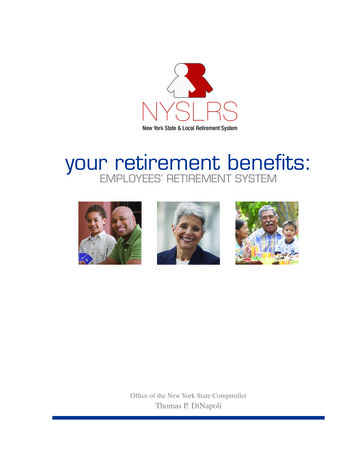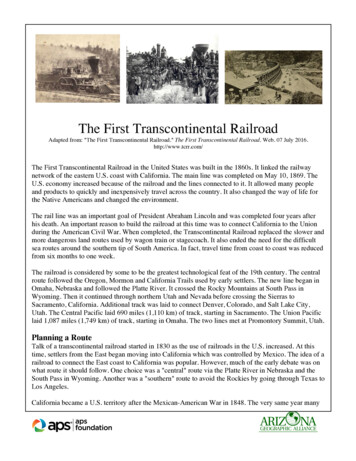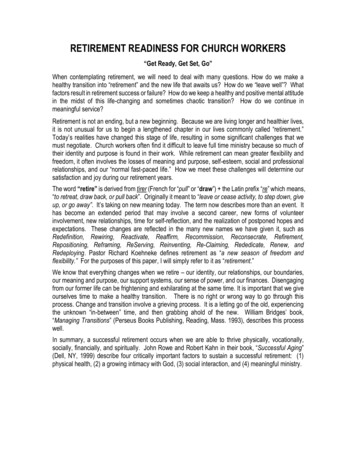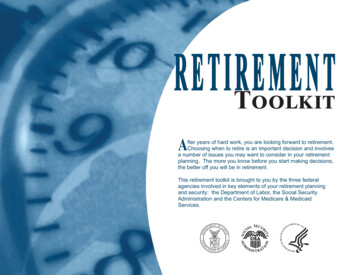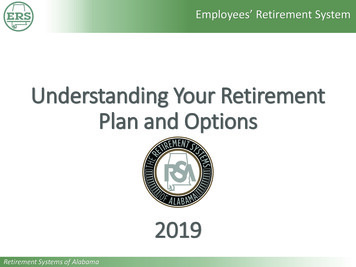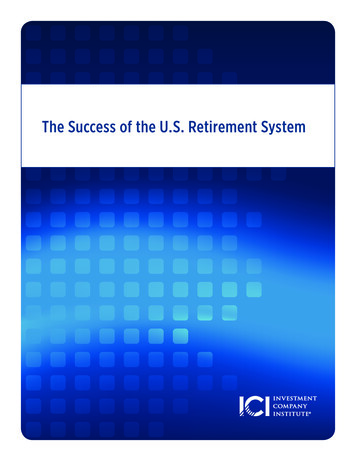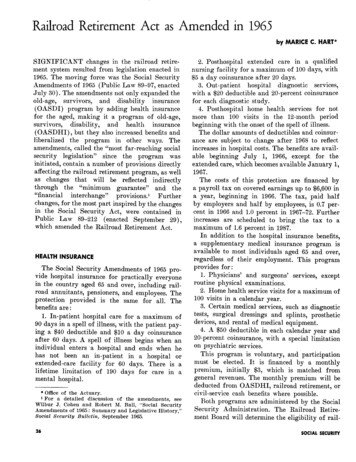
Transcription
Railroad Retirement Act as Am.ended in 1965by MARICE C. HART*SIGNIFICANTchanges in the railroad retirement system resulted from legislation enacted in1965. The moving force was the Social SecurityAmendments of 1965 (Public Law 89-9’7, enactedJuly 30). The amendments not only expanded theand disabilityinsurancesurvivors,old-age,(OASWP ro g ram by adding health insurancefor the aged, making it a program of old-age,survivors,disability,and healthinsurance(OASDHI), but t.hey also increased benefits andliberalizedthe programin other ways. Theamendments, called the “most far-reachingsocialsecuritylegislation”since the programwasinitiated, contain a number of provisions directlyaffecting the railroad retirement program, as wellas changes that willbe reflected indirectlythroughthe “minimumguarantee”and anges, for the most part inspired by the changesin the Social Security Act, were contained inPublicLaw 89-212 (enacted September 29),which amended the Railroad Retirement Act.HEALTH INSURANCEThe Social Security Amendments of 1965 provide hospital insurance for practicallyeveryonein the country aged 65 and over, includingrailroad annuitants, pensioners, and employees. Theprotectionprovidedis the same for all. Thebenefits are :1. In-patienthospital care for a maximum of90 days in a spell of illness, with the patient paying a 40 deductible and 10 a day coinsuranceafter 60 days. A spell of illness begins when anindividualenters ‘a hospital and ends when hehas not been an in-patientin a hospitalorextended-carefacilityfor 60 days. There is alifetimelimitationof 190 days for care in amental hospital.-*Office of the Actuary.1 For a detailed discussion of the amendments, seeWilbur J. Cohen and Robert M. Ball, “Social SecurityAmendments of 1965 : Summary and Legislative History,”Social Xecurity Bulletin, September 1965.262. Posthospitalextended care in a qualifiedfacility for a maximum of 100 days, with 5 a day coinsurance after 20 days.hospitaldiagnosticservices,3. Out-patientwit,h a 20 deductible and 20-percent coinsurancefor each diagnostic study.4. Posthospitalhome health services for notmore than 100 visits in the 12-month periodbeginning with the onset of the spell of illness.The dollar amounts of deductibles and coinsurance are subject to change after 1968 to reflectincreases in hospital costs. The benefits are available beginningJuly 1, 1966, except for theextended care, which becomes available January 1,196’7.The costs of this protectionare financed bya payroll tax on covered earnings up to 6,600 ina year, beginningin 1966. The tax, paid halfby employers and half by employees, is 0.7 percent in 1966 and 1.0 percent in 1967-72. Furtherincreases are scheduled to bring the tax to amaximum of 1.6 percent in 1987.In addition to the hospital insurance benefits,a supplementarymedical insurance program isavailable to most individualsaged 65 and over,regardless of their employment.This programprovides for :1. Physicians’and surgeons’ services, exceptroutine physical examinations.2. Home health service visits for a maximum of100 visits in a calendar year.3. Certain medical services, such as diagnostictests, surgical dressings and splints, prostheticdevices, and rental of medical equipment.4. A 50 deductible in each calendar year and20-percent coinsurance, with a special limitationon psychiatric services.This program is voluntary,and participationmust be elected. It is financed by a monthlypremium, initially 3, which is matched fromgeneral revenues. The monthly premium will bededucted from OASDHI,railroad retirement, orcivil-servicecash benefits where possible.Both programs are administered by the SocialSecurity Administration.The RailroadRetirement Board will determine the eligibilityof rail-nursingSOCIALSECURITY
road annuit.ant.s and employees for hospitalbenefit’s and certify to that effect. to the SocialSecurity AdministraGon,which will be responsible for paying for the services. In addition, theRailroad Retirement Board will arrange for reimbursementfor hospital expenses incurred inCanada to the extent that they are not covered byProvincialinsurance programs.The hospital tax will be collected as part of thetotal payroll tax on railroad compensation andwill be transferredto the hospitalinsurancetrust fund, set up by the 1965 amendments, fromthe railroad retirementaccount under the provisions of the financial interchange. Allowanceis to be made for administrativeexpenses incollecting the taxes and in certifyingeligible persons. The premiums for supplementarymedicalinsurance that are deducted from railroad retirement annuities will be transferredperiodicallyto the new supplementarymedical insurancetrust fund.others are less, his taxable compensation for ayear is less than 12 times t,he monthly base.As enact,ed, the Social Security Amendmentsof 1965 contained a proviso that, in calendaryears in which the railroad monthly base wasexactly one-twelfththe OASDHIannual base,the hospital tax on railroad compensation wouldbe assessed in the same manner as the payrolltax levied for railroad retirement cash benefits.TABLE l.-Maximummonthly taxable railroad compensationand maximum annual taxable earnings under Social SecurityActI---,Compensationbase, RailroadRetirement ActPeriodEarningsbase. SocialSecurity ActI----1837-50 .-.-. . .-- - . .-.---.----.---.-.-.--July-Dec.-.-.------.----- --------1955-58.--.--.-.--. - -.-.-- -:s96&62 - . . . .Jan.-Ott - .--. .-------.1966and after--. .-. .----------OTHER MAJOR CHANGESSome of the other revisionsretirement program were madechanges in the Social Securitysulted automaticallyfrom ationin the railroadto conform withAct. Others rechanges, but onedeveloped inde-BaseIn the amendments to the Social Security Act,Congress provided that the earnings t’ax coveringt,he cost of hospital benefits be separately identified from the tax to finance cash benefits. Somequestions arose about the effect of the hospitaltax on the financing of the railroad retirementsystem because in the past the maximum monthlytaxable compensation under the Railroad ReGrement Act has differed significantlyfrom themaximum earnings base under the Social SecurityAct. Some difference between the two bases existseven when the railroad base is exactly one-twelfthof the annual base under the other program because, when a railroademployee?s earnings insome months are greater than t,hat base and inBULLETIN,FEBRUARY1966Otherwise, the railroad compensation would bedirectlysubject to the hospital tax under theSocial Security Act.The amendments to the Railroad RetirementAct accordinglyset the railroadbase at onetwelfththe OASDHIbase for future years.Beginningin January1966, the maximummonthly taxable compensation is increased from 450 to 550, or one-twelfththe earnings baseunder the Social Security Act. In the past, asshown in table 1, the railroad monthly base hasequaled or exceeded one-twelfth of the OASDHIbase at all times except for the 5 months JanuaryMay 1959. In 18 of the 29 years from 193’7through 1965, it has exceeded one-twelfth of thatbase.This automatic coordinationin future yearsis significant not only in connection with hospitalbenefits but also in the financing of the railroadretirementcash benefits. Under the financialinterchange, the OASDHIsystem receives creditfor taxes on railroad compensation equal to theamount that would be collected if railroad employment were directly covered. Under previouslaw, the railroadcombined employer-employeetax rate, beginning in 1965, had been set at 9 per27
cent plus the tax rate under t,he Social SecurityAct. One source of extra financing for the railroad retirementsystem, t,herefore, had been ahigher base than that under the Social SecurityAct and retention of the amounts collected fromapplicationof the OBSDHIportion of the taxrate to compensation in excess of the earningsbase for that program.Tax RatesUnder the law before the 1965 amendments, thecombined employer-employeetax rate was scheduled to rise from 161h percent in 1965 to 171/bpercent in 1966-thatis, 9 percent plus thepreviously scheduled 81h-percent rate under theSocial Security Lt.After passage of the 1965amendments to that Act, the 1966 railroad retirement rate (includingthe hospital rate) -0 1 1have been 1’7.4 percent.To reduce the impact of both an increased taxrate and an increased compensation base, the railroad tax rate was temporarilyreduced 2 percent(1 percent each for employers and employees).The reduction was made effective immediatelyupon enactment, for the month of October 1965,with one-fourt,h of the scheduled reduction to berestored in January of each of the years 1966through 1969, when the cut would be completelyrestored. The tax rates since 1937, and fut,urerates scheduled under present law, are shown intable 2 for both the O14SDHI and railroad retirement’ programs, separately for cash benefits andhospital insurance.Spouse’s BenefitsIndependentlyof the amendments to the SocialSecurity Act a bill was passed by the House ofRepresentatives to eliminate the reduction in therailroadretirementspouse’s annuitywhen theindividualalso receives a railroad annuity basedon his own earnings or any OA4SDHI benefit otherthan a wife’s benefit. (The most, usual case wasthat of a woman- who received a railroad retirement wife’s annuity under the Railroad Retirement ,4ct and an old-age benefit based on her ownearnings record under the Social Security ,ict ;her railroad wife’s annuity was reduced by the28amount of the old-age benefit.) This bill, amendedin the Senate to revise the compensation base andmake other, minor changes, was t.he basis of the1965 amendments to the Railroad Retirement Act.The reduction was eliminated,beginningwithannuities accruing for Oct,ober 1965.TABLE2.-Combinedemployer-employee tax rates 1Social Security ActPeriodOASDIIIIiTotalRailroadRetirement Act---AdditionOA&llltax rateHoszi”,i.fltsg?kfits!ITotnliRate (percent) under past financingI------1937-39 .1940-42 . .-.1943-45. . /1948.-.-.’1947-48. . .I19491950-51. . . .1952.53 .19X-56 .1957-58 .1959:Jan.-MW.JWle-Dec.lQlWFI. .-.1962.-w.lQ6%6.1985:am-srpt. OCt.-I PC.2.002.002.002. no2.002.003.003.004.004.50I.-. /2.002.002.002.002.002.00. . . . . . . . . . . . .'. .-. . . . . . . . . . . . . . . . ;:;;4.004.50,;:::::::::::I. . . . . . .5.on5.006.flO6.257.251 5.00.-.). . .I5.00. . . .'8.00. . . .'6.25. . . . i.257.257.25. . . . .Ii.257.255.50I . .I6.00 ’6.50. . .5.566.006.507.Ml11.5012.0012.0012.5012.5012.50I . . . . . . . .-. .-. . . . . . . .9.07.012.5013.5013.5014.5014.50. .-. .- . . .12.5016.2514.25. .-.16.2514.25-- -13.5013.5014.5014.56Rate (percent) under scheduled future 79.i.70 20.1026.301 iVanimun earnings subject to tm we shown in table 1.A proviso was also added to protect spouseswho had received a lump sum instead of amonthly annuity. For some years it had been thepractice of the Railroad Retirement Board, whenmonthly annuities were less than 5, to pay thecommuted value in a lump sum. With respect tospouse’s annuities, this procedure was most oftenfollowed when the annuity had been reduced because of receipt of another benefit. For thesecases, under the IN& law, beginning with benefitsfor October the spouse’s monthlybenefit ispayable but is reduced by the monthly amountfor which the commuted value had been paid ina lump sum.A further change in spouse’s annuities was anautomaticresult of the Social SecurityActamendments. Such an annuity, under the RailSOCIALSECURITY
road RetirementAct, is one-half that of theretired employee, but it is subject to a dollar maximum equal to 110 percent of the maximumOASDHIwife’s benefit. The 7-percent increasein OASDHIbenefits raised t,his maximum, retroactivelyto January1965. Furtherand moresubstantial increases will result from the higherearnings base, which increases the maximumwife’s benefit under the Social Security Act infuture years. The previous maximum wife’s benefit of 69.90 becomes:MonthlyBeginning in January1965 --------------------------------1967 ------ --------- ------------1968 - -------- ------- ---- amount 74.8083.6092.40Coverage of TipsConformingto the extension of OASDHIcoverage to tips, the railroad retirement amendments provide that tips of 20 or more receivedby railroad employees in a month are subject tothe employee tax, but not to the employer tax,and are creditable in the computation of benefits.The employee is required to report his tips tohis employer, and the latter is required to withhold the employee share of both the payroll taxand income tax, to the extent. that he has fundsof the employee in his possession.Increases in AnnuitiesAs a result of the 7-percentincrease inOASDHIbenefits, railroad retirement annuitiescomputed under the minimumguarantee willgenerally also be increased by 7 percent. Certainother liberalizationsin the Social Security Actwill also increase railroadannuities. Probablythe most significant is the availabilityof benefitsto childrenaged 18-21 who are in full-timeattendance at school. Althoughthere is no provision in the railroadretirementprogram forthe payment of benefits to such children,theamounts payable to their families may be increased on t.heir account. In addition,the increased earnings base under the Social SecurityAmendmentsof 1965 and eliminationof theprevious fixed dollar maximum for family benefits result in a railroadretirement, maximumBULLETIN,FEBRUARY1966familybenefit under the minimumguarantee(generally applicable for survivor families) thatrises from 279.40 under the previous law to 340.20in 1965, 373.20 in 1966, and 404.80 in1967 and after.Higher amounts will also be payable to survivor annuitants engaged in non-railroademployment and subject to t,he social security earningstest, which provides that no benefits will be withheld if earnings do not exceed 1,500 in a calendaryear. For each 2 of earnings between 1,500 and 2,700, 1 of benefits is withheld, and for each 1of earnings over 2,700, 1 of benefits is withheld.Benefits are not withheld, however, for any monthin which remunerationis 125 or less and thereis no substantial self-employment.This test alsoapplies to retirement and disability annuitants tothe extent that their annuities are increased byt’he minimum guarantee. The test was liberalizedin the Social Security Amendments of 1965. Theexempt amount had been 1,200; the l-for- 2band was 500, so that 1-for- 1 withholdingbegan with earnings over 1,700; and the monthlytest was 100.LEGISLATIVE DEVELOPMENTAs indicated above, these changes in the railroad retirement program were for the most partinspired by, and in large part contained in, theSocial Security Amendmentsof 1965. A brieflegislative history may be of interest.In the Administration’sproposal to includehospital benefits as a part of the OASDHIprogram, railroad retirement annuitants and railroademployees aged 65 and over were included ; theirprogram was to be administered by the RailroadRetirement Board. During considerationof thelegislation, however, the Ways and Means Committee of the House of Representatives expressedconcern because of the different wage bases of thetwo programs and, more important,because ofthe added burden that might be placed on providers of service who would have to deal withtwo agencies of the Federal Government in securing reimbursements for hospital costs.Z As the billpassed the House, therefore, railroad retirementZSocial Security Amendments of 1965: Report . . . onH. R. 6675 (House Report No. 213, 89th Cong., 1st sess.),1965.29
Principalprovisionsof the RailroadInitialqualifications for benefits :Minimumof 10 Years of railroadservice requiredto qualifyfor all benefits under the RailroadRetirementAct exceptresidualdeath payment(see item A (8) ). Personswithless than 10 Years of service are transferredto OASDHIsystem.A. Benefits(1)(2)(3)payableto-Age nnnultant:Aged 62 or over, with annuityreduced l/lSOfor eachmonth under age 65 at time of retirement:or aged 60or over if at least 30 years of service,with annuityfor men reduced l/180for each month under age 65 attime of retirement.Disabilityannuitant:Unable to engage in any regularemploymentor unableto engage in usual occupationif havingcurrentconnection with railroadindustrywhen disabled and eitherhaving 20 years or more of service or aged 60 or over.Spouse of annuitantaged 65 or over:Aged 62 or over, with annuityreduced l/180for eachmonth under age 65, or at any age with child in careif child would qualifyfor survivorbenefit on death of(5)(6)(7)(8)(1)(2)(3)(4)(5)30Widow:Aged 60 or over, or at any age withchild in care ifchild qualifiesfor survivorbenefit. Dependentwidoweraged 60 or over.Child of deceased individual:Under age 18, or aged 18 or over with a disabilitythatbegan before age 18.Dependentparent :Aged 60 or over, and no survivingspouse or child whocould ever receive monthlybenefits.Lump-sumdeath payment:Generallyfordeathswhenno monthlybenefitsareimmediatelypayable.Residualdeath payment :Payable after all benefit rights,includingthose of tionfor those withless than10 Years ofservice.B. Insuredstatus for survivorbenefitsQuarterof coverage :(a) Compensationquarterof coverageis in effectacalendarquarterto whichat least 50 of railroadcompensationis credited.(b) Wage quarterof coverageis a quarterof coveragecreditableunderOASDHI;in general,a calendarquarterin which at least 50 of wages was paid.Currentconnection:In general,existsat time of retirementor deathifworkerhad 12 months of railroadservice in preceding30 months.Completelyinsuredstatus :(a) Currentconnection,and (i) 1 quarterof coveragefor each 2 quartersafter 1936 (or after age 21 iflater)and before age 65 (or death or retirementifearlier),with minimumof 6 quartersof coverage;or (ii) 40 quartersof coverage;or (iii) fully insured,on basis of combined earnings,under Social SecurityAct; OT(b) Receiptof retirementannuitybased on at least10 years of service before 1948.Partiallyinsured status :Currentconnection,and 6 quartersof coveragein Yearof death or retirementand 3 precedingYears, or currently insured under OASDHI.Transferof credits to OASDHIsystem :If not insuredas in items(3) and (4). railroadcompensationused in determiningsurvivorbenefits underOASDHI.Act, 1965c. Amountof retirementbenefits(1)Years of service :All serviceafter1936 plus (for those in “emPloYmentrelation”on Aug. 29, 1935) service before 1937 thatbrings the total to not more than 30 Years.(2)Averagemonthlycompensation:Averageof creditablecompensationpaid in periodOfservice counted ; maximummonthlyamountcreditable1959.- 300before July 1954, 350 for July 1954 May 400 for June 1959-October1963, 450 for November1963-December1965, and 550 after 1965.(3)Monthlybenefit amount:3.35% of first 50 of monthlycompensation,plus 2.51%of next 100, plus 1.67% of next 400, all multipliedby years of service.(4)Minimumbenetlt amount:(a) If currentconnectionat retirement,amountdetermined under item(3) shall not be less than theleast of 83.50, or 5.00 times years of service,or110% of average monthlycompensation.(b) OASDHIminimumguarantee(see item G (8) ).annuitant.(4)RetirementD. neration:Basedon railroadcompensationand earningsunderSocial Security Act from 1937 to year employee attainedage 65 and was completelyinsured,or year of deathsucceedingyear),dividedby elapsedperiod(or(omittingperiodsduringwhicha retirementannuitywas payable).Maximumcombinedearningsare 3,600a year through1954, 4,200 for 1955-58, 4,800 for1959-65,and 6,600 thereafter.(Compensationaloneis creditableto a maximumof 3,900 in 1954, 4,550in 1959, 4,900 in 1963, and 5,400 in 1964-65.)(2)Basic amount:49% of first 75 of ax-erage monthlyremunerationplus12% of remainder,increased by 1% for each year after1936 with 200 or more of remuneration.Minimumbasic amount is 16.95.(3)Maximumfamily benefits: 193.60or 2 timesbasic amount,whicheveris less,butnotless than 36.30or OASDHIminimumguarantee(up to 404.80 beginningin 1967).(4)Minimumfamilybenefits : 16.95 or OASDHIminimumE. Amountsof dependentguaranteeand survivor( 48.40).benefits(1)Spouse:50%of retirementor disabilityannuity(beforeanyreductionfor retirementbefore age 65 or joint-andsurvivoroptionelection).hlaximumis 110%of themaximurnwife’sbenefitunderOASDHI( 92.40beginningin 1968).(2)Widow or widower:100% of basic amount.Notreceived immediatelybefore(3)Child of deceased worker:66% of basic amount.(4)Dependentparent:66% of basic amount.(5)Lump-sumdeath payment:10 times basic amount.(6)ResidualSpecifiedless than spouse’s annuitywidow’sannuityis payable.death payment:Percentagesof compensationless benefitsSOCIALpaid.SECURITY
PrincipalF. tshospitalcare, posthospitalhome health services,andprovidedunder gram,withrelatedmedicalpremiumof the tsprovidedunderdeducted from annuity.OASDHIG. Miscellaneousbenefitprovidedcare, postdiagnosticEmploymentpermittedretiredworkersand spouses:None for any railroador for last employerbefore retireNo plies (and then only with respect to abilityannuitants:None for any railroador for last employer.Earningsof 1,200 a year in wages and self-employmentpermittedwhileunder age 65; 1 month’sbenefitwithheldforevery 100 of annual earningsin excess of 1,200, butno deductionsfor months with earningsof 100 or less.After age 65, same as item ne for any railroad.Otherwiseto the same extentasfor OASDHIbeneficiaries(full benefits if earnings fromwages and self-employmentare 1,500 or less a year,but in any event for monthswith 125 or less ofwages and no substantialservice in self-employment);this test also applicableto work activityoutsidetheUnited States.(4)Effect of railroadRailroadearningspayable.(6)work on OASDHIcash benetlts:counted in determiningif benelltsDuplicationof benefits under railroadSurvivorbeneficiarymay concurrentlyannuity.Duplicationof retirementOASDHIbenetlts :Allowedwithno ants were covered under the social securitysystem for hospital benefits, and the separate taxto cover the cost of the hospital program was tobe applied to railroad compensation just as if itwere employment covered by the Social SecurityAct. The compensation would be reported to theSocial Security Administration,and the taxeswould be collected by the Internal Revenue Service and equivalent amounts appropriateddirectlyto the hospital insurance trust fund.The Senate amended the bill to provide foradministrationof t,his program by t,he RailroadRetirement Board if the railroad retirement basewas equal to at least one-twelfththe base underthe Social Security Act. In conference it wasagreed that, if the railroad retirement base wasexactly one-twelfththe OASDHIbase in anyBULLETIN,FEBRUARY1966Duplicationof survivorbenefits withAllowed(except beneilts not payableon basis of same wage record).(8)OASDHIminimumguarantee :Retirementor survivorbenefitswillnot be less than110%of the amount(or additionalamount)thatwould be payable by OASDHIsystem if railroadservicewere covered employmentunder that system.(9)Credit for militaryservice:Imputedcompensationof 160 a month during war service if in railroademploymentin year of entryintomilitaryservice or in preceding year. Provisionsagainstusing same service under more than 1 Federal system.(10)Time withinwhich benetlts must be claimed :Lump-sumdeath paymentwithin2 years. No limitforresidualdeath payment.Monthlybenefitsretroactivefor 12 months.OASDHIbenefits:under both systemsH. Financing(1)Tax rates :Combinedrates,sharedequallyby employerand employee,paid on maximumcompensationof 550 amonth(after1965) : 3-75-19.8%,197679-19.9%,1980-86-20.1%,1987 and after-20.3%.(2)Governmentcontributionfor militaryservice :Actuariallydeterminedcost of additionalbenetltsformilitaryservice before 1937 and after June 1963, plusfor the latter an allowancefor administrativeexpensesand for intereston unfundedaccrued liability.Regularemployer-employeetaxes on creditablemilitaryservicebased on imputed earnings of 160 a month for January1937 June1963.(3)Interestrate on investments:Equal to averagemarketyield borne by all marketableinterest-bearingobligationsnot due or callablefor3 years from date of investment,rounded to the nearestl/8%,with a minimumrate of 3%.(4)Financialinterchange:OASDHItrust funds to be put in same positionin whichthey would have been if railroadservice after 1936 hadbeen covered employmentunder Social SecurityAct.retirementannuityAct, 1965 Continued(7)provisions(1)(5)Retirementyear after 1965, the hospital insurance tax wouldbe applied to the compensation reported to theRailroad RetirementBoard and the additionaltax for that program appropriated,with the taxfor railroad cash benefits, to the railroad retirement account. Under financial interchange procedures, the amount of the tax would be transferredannuallyto the hospital insurance trust fund,after allowance for the cost of administrationandof certification to the Social Security Administration of eligible railroad retirement employees andannuitants. Costs of hospital and related benefits,however, would be paid by the Social SecurityAdministration,except that t,he Railroad Retirement Board could arrange for provision of suchservices to eligible employees and annuitants inCanada.31
In the meantime, a bill (H.R.3157) eliminating the reduct,ion in spouse’s benefits because ofreceipt of other railroad retirement or OASDHIbenefits had passed the House of Representatives.In the Senate, it was amended to provide that therailroad retirement compensation base in futureyears would be equal to one-twelfththe earningsbase under the Social Security Act. Since underthe Constitution,however, revenue bills mustoriginate in the House, a new House bill (H.R.108’74) was introduced containing the provisionsthat had already been passed by the Senate, including a S-percent temporary reduction in thetax rate and extension of coverage to tips. Thisbill, passed by both Houses withoutdiscussionand signed by the President on September 29,became Public Law 89-212.AMENDED PROGRAMThe provisionsof the RailroadRetirementAct, as amended, are outlined in the accompanying chart. The principalchanges are the elimination of the reduction in spouse’s benefits, thechanges in compensation base and tax rates, andthe addition of health insurance for the aged.The act as amended makes the future maximummonthlytaxable compensationbase, tax rates,and maximumspouse’s benefits automaticallydependent on future changes in the Social Security Act. The amounts of annuities payable underthe minimumguaranteewill continue to beaffected by changes in that law.Beforethe amendmentswere enacted theactuarialdeficiency of the railroadretirementsystem was about 20 million on an annual basis,or about 0.45 percent of taxable payroll. Theamendments to the Social Security Act increasethe deficiency by 28 million annually, to about1.11 percent of taxable payroll. The amendmentsto the RailroadRetirementAct increase thetaxable payroll and provide about 84 millionannually in additionalincome. Of this amount, 14 million will be required to cover the cost ofeliminatingthe reduction in spouse’s benefits and 46 million to cover increases in annuities resulting from the higher compensationbase. Thebalance-about 24 million on an annual basis-isjust short of the amount needed to cover theadded costs of the Social Security Amendments of321965. After allowance is made, however, for thetemporary reduction in tax rates for the periodOctober 1965-December 1968, the net effect is anincrease in the actuarial deficiency to about 30million on an annual basis, or 0.62 percent oftaxable payroll.It may be noted that the hospital insuranceprogram has practicallyno cost impact as faras the railroad retirement system is concerned.The payroll taxes for that program will be transferred to the hospitalinsurancetrust fundthrough the financial interchange, after allowancefor administrativeexpenses, and benefits willbe paid directly from that fund. There will besome effect, however, because the taxes collectedwill be based on monthly maximum earnings of 550, but transfers to t’he hospital insurance trustfund will be based on maximum annual earningsof 6,600. The difference between the amountsis probably about l percent of payroll, or about 75 million a year. For 1966, the result will be aliabilityof about 500,000 more than the taxesactually collected ; the amount will increase toabout 750,000 for the years 1967-72. In addition,t.here will be an annual cost of perhaps 200,000for hospital benefits provided to eligible railroadannuitants and employees in Canada, which willbe reimbursed directly from the railroad retirement account.Relationship Between RailroadRetirement and OASDHIThere is direct coordinationbetween the syst
SIGNIFICANT changes in the railroad retire- ment system resulted from legislation enacted in 1965. The moving force was the Social Security Amendments of 1965 (Public Law 89-9’7, enacted . for the most part inspired by the changes in the Social Security Act, we


